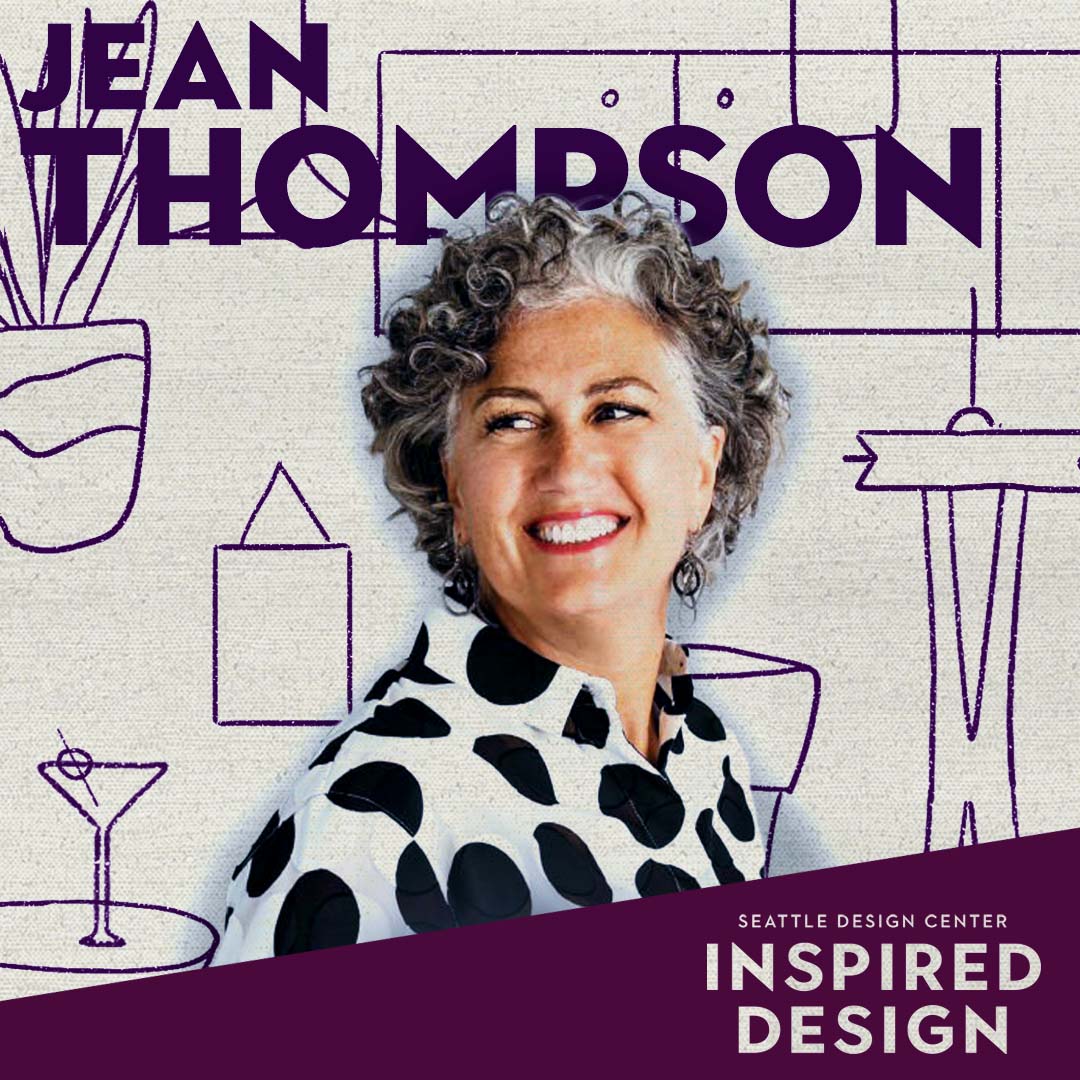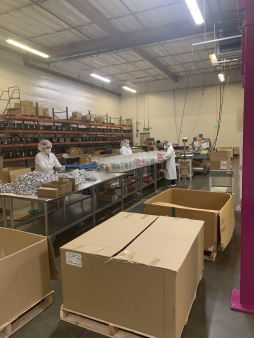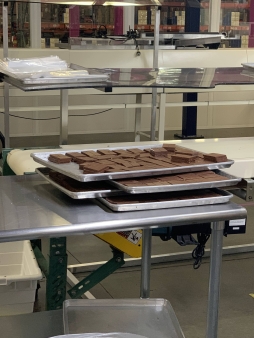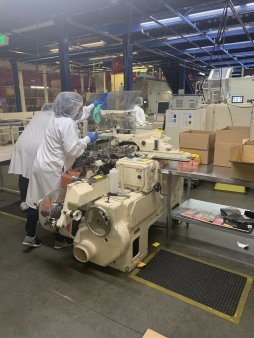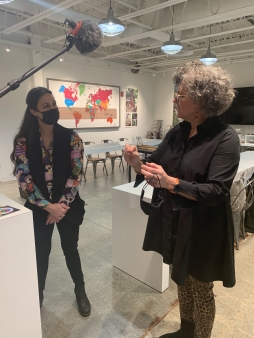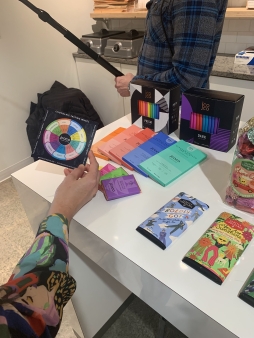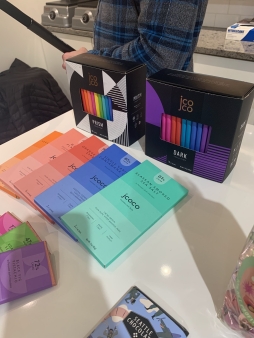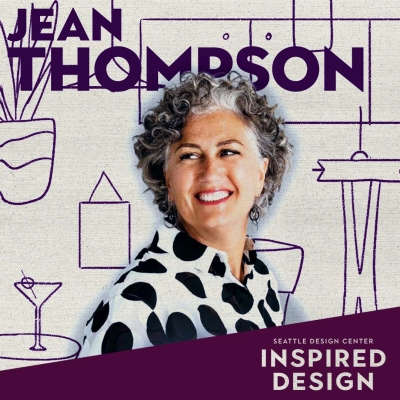
Jean Thompson | Sweet & Savory
In this episode of Inspired Design, get a mouthwatering education in all thing’s cocoa as Owner and CEO of Seattle Chocolate Company, Jean Thompson, gives us an inside tour of their newly renovated headquarters and factory. To top it, off she infuses her entrepreneurial wisdom leaving us ready to make the world a better place one small decision at a time!
Listen on your platform of choice
[abcf-grid-gallery-custom-links id=”5073″]
Explore this Episode
Learn More
TOUR THE CHOCOLATE FACTORY
VALUES
At Seattle Chocolate Company, we’re endlessly inspired to evolve, to be better to each other and the planet, and to leave the world brighter (and more delicious) than we found it. What matters most to us is how we source our chocolate, the environmental impact the production of our chocolate has, and how, with your help, we can give back through chocolate. Read on to learn more about the journey each of our products takes, from the cacao tree to you.
MISSION
To put it simply, we just want to make the world a little sweeter. Nothing leaves our factory until we’ve stamped it delicious, including a smooth truffle mouthfeel and an imaginative flavor combination (Mexican Hot Chocolate, Pink Bubbly, and Neapolitan, just to name a few). We’re obsessed with color and know that collaboration breeds creativity in the best way, so we work with independent artists around the world to illustrate our whimsical chocolate bars and gifts – all in hopes of making you smile.
We’re risk-takers and chocolate-makers, here to brighten your day. Join the fun.
Episode Transcript
Jean Thompson:
So somebody had like one of those security camera at their front stoop and they had a delivery of Seattle chocolate, and a squirrel got into it. He caught the whole thing on video and sent it to us. And he burrowed his way in, pulled the one pound bag out of the carton and then he dug into that and unwrapped a truffle and eat it. I’m like, “See all creatures, big and small love chocolate.”
Gina Colucci:
I’m Gina Colucci with the Seattle Design Center. Every week on Inspired Design, we sit down with an iconic creator in a space that inspires them. On this episode of Inspired Design, we head to Seattle chocolate’s headquarters and factor and meet up with owner and CEO of nearly 20 years, Jean Thompson.
Jean Thompson:
So these are lab coats and then for all hair, up in the hat.
Gina Colucci:
We begin our tour of the factory by suiting up.
Jean Thompson:
If you want to simulate the experience that they go through.
Gina Colucci:
Jean handed us big white lab coats, and then we had to put on hairnets. We had to wash our hands and put on gloves.
Jean Thompson:
Seems funny you have to wash our hands before you put gloves on, but apparently germs can make their way through this barrier.
Gina Colucci:
We couldn’t wear open toed shoes, and we were advised to wear a warm jacket because the factory floor was chilly.
Jean Thompson:
We even have a little mirror so you can check.
Gina Colucci:
Once we were suited up, I checked myself out in the mirror, but Jean reminded us that that mirror wasn’t actually glass because if any glass got in the factory, it would be a huge issue.
Jean Thompson:
Glass is something you really can’t detect when it breaks and it literally could kill somebody if a piece of glass broke, so zero glass in our facility, so even that’s just a reflective metal.
Gina Colucci:
Once we were suited up, we stepped out onto the factory floor.
Speaker 3:
This is a milk chocolate, and so they pipe in tempered chocolate. Tempers is a process, as part of chocolate making that is done by those machines, heating and cooling it to give it a particular crystal structure. And then they put it in here and this becomes the center of our truffle bar, so that happens here in the kitchen. And then it gets piped over the side into the bar moulds, which we’ll show you downstairs.
Gina Colucci:
This was a huge warehouse and you could smell the chocolate and the ingredients. It’s like an orange back there?
Speaker 3:
You got orange, you got a little something like a cinnamon or clove or something. Yeah.
Gina Colucci:
There were machines and tubes and refrigerators, workers moving about in a very systematic way, and there were conveyor belts, and used moulds for the chocolate. Everything was very orderly and intentional. Each worker knew exactly what they were doing. You could tell that the systems in place were working very well.
Speaker 3:
What I’m going to show you now is our bar line where we make our bars.
Gina Colucci:
I almost felt like we were in Willy Wonka.
Speaker 3:
So this is a jcoco mould, in fact, so there’s nine bars up on a single molds and it goes through the line. Basically what happens is, there’s a deposit of chocolate here. This plate comes down and compresses it into a shell, and then here, they put the center in that we saw upstairs in the kitchen. Whoever’s standing in this position will put like nuts or what we call inclusion could be raising, could be cherry or something go in here by hand. And then the centers go in. They make their way through a cooling tunnel and get bottomed. So there’s three layers that are made on this line. And then they go back through the cooling tunnel, you can see the robotic arms, take the bars out of the moulds and put them on a conveyor belt. I think this is the quinoa sesame bar for jcoco.
Gina Colucci:
We headed over to the production area and it was a combination of some state-of-the-art machinery and some old machines. And you could tell the people working there have had a lot of experience maintaining these old machines. They didn’t even skip a beat when something broke.
Speaker 3:
A lot of them have been here 15 years, 10 years. They’re really good at keeping these machines working. And so she’s literally fixing it right now, she’s not calling over the engineer. She’s like, “I know how to do this.”
Gina Colucci:
How many different flavors are in production at once?
Speaker 3:
Well, we have two machines. One that makes the truffles and one that makes the bars and they’ll run at 300 pound batches so just one at a time.
Gina Colucci:
Both machines produce 300 pounds of chocolate per batch, which seems like a lot. But when you think about it over a year, the whole factory produces a million pounds of chocolate.
Speaker 3:
And this is the quinoa sesame bar that I thought it was.
Gina Colucci:
The two brands are very distinct. Seattle chocolate is your classic chocolate bar with a variety of fun flavors and colorful packaging and partners with talented artists. And then jcoco is the luxury chocolate bar, which can be more adventurous with the flavors.
Jean Thompson:
Basically our purpose in life is to brighten people’s day with chocolate. So Seattle chocolate is really how we do that. And jcoco goes in a little bit of a different direction for chocolate. 10 years ago, we’re in our 10th year of jcoco and I wanted a product that wasn’t regionally named so we came up with jcoco and J is for Jean and cacao is for chocolate. And this one is kind of going more in the, I’m going to say, foodie, artisan food kind of direction, where we’re really celebrating chocolate, like a cacao product.
Jean Thompson:
So this is what has happened in wine and beer and in the spirits and coffee even. We’re trying to be part of a sort of a renaissance for chocolate, for cacao. Cacao been around for millennia, literally. And then somehow it got sort of relegated to the candy aisle and what happens in the candy aisle, I love candy, but there’s only a certain amount people are willing to pay for it.
Jean Thompson:
All chocolate is extremely labor intensive. It starts in some sort of equatorial nation very far away, farmers, fermentation, drying, roasting, winnowing, refining and then it gets to us. And then we further temper and mould and wrap and sell and market and goes to the brokers. I mean, there’s 15 people that touch that chocolate bar and everybody’s adding a lot of value, and yet you’re only charging $2 for it? I mean, it’s just not there.
Jean Thompson:
So what’s happening is, with the farmers are not eking out a very good living and it’s a real problem for the whole industry. I feel what needs to happen is that we just celebrate chocolate much like you’ll pay $4.50 for a coffee. That’s literally a steeped bean and some milk added to it, I mean, I know there’s a lot of art there, but it’s not an expensive. And you don’t bat an eyelash at it but then you’re like, “Oh my gosh, $3 for chocolate bar?” Because you don’t understand. And you think of it as a cheap bar or cheap candy.
Jean Thompson:
So jcoco is all about sort of furthering the chocolate renaissances, I’ve coined that. I did a Ted talk in 2019 on this. And at the end of the day, I believe it’s the low prices on chocolate and this artificially low ceiling and low perceived value of chocolate. We think of it as a candy at Halloween and Easter that kids should eat and it’s cheap, but it’s not. It can be an amazing delicacy, but the chocolate makers are pinched by this situation. Because if you can’t charge enough for the chocolate, then you can’t afford to pay more for the chocolate. And here we stay in this catch-22.
Jean Thompson:
The chocolate industry just needs people to understand the nuances of the cacao bean. Do people know it’s a fermented product? Do people know that it’s grown on a tree and that the pods look a certain way and that there’s 10 different varietals, like there are varietals of wine. So there’s so much knowledge that that’s kind of our mission here at the tour. You can come on a tour and we educate you a little bit about the history of chocolate and how we make it, and then there’s the tasting wheel that you’re looking at here. It looks familiar if you’ve ever gone on a wine tasting. Of course the adjectives are different for chocolate. Chocolate is stringent, chocolate is bitter, chocolate is acidic, that’s part of the beauty of it. But the balance of those things, you’re going to have a personal preference on.
Jean Thompson:
So when you taste the chocolate, you’re going to think about, oh, this one’s very acidic, it tastes like fruit, it tastes like whatever, it tastes like malic acid, or like an apple, or it tastes like acidic acid, like vinegar, or it tastes like other acids, but you’ll be able to sort of put words to it. And I think then you’ll start developing your own preferences. So we’re all about furthering this and jcoco is how we do it. That’s kind of the difference and the reason why we have two brands.
Jean Thompson:
So we have, I think 11 flavors in the line and these gift boxes have 10 of them, so I’m going to use those. They’re missing the Alaskan smoked sea salt is not in these boxes so I can use the box as a cheat sheet. So we’ve got a 72% dark with nibs from that bean in Peru. All this chocolate is from Peru, by the way, I forgot that key part. And then next we have white chocolate with orange and cayenne pepper, which is an amazing accompaniment to a smoked whiskey.
Jean Thompson:
And then you have the mango plantain, which are first dried chunks of mango, and then crispy plantain chips in a milk chocolate. And our milk just to point out is 47% cacao. So by contrast, there are everyday chocolate bars in the grocery store that the darks are 45% and a milk chocolate for some of our products that we won’t name are less than 20% cacao, the rest of it is all fillers and sugar and stuff. So this is a very interesting milk chocolate, because it’s got a lot of cacao in it.
Jean Thompson:
The orange blossom espresso is a milk chocolate with orange and espresso. People love that sort of classic European. This one’s my personal favorite because it’s 85% dark, so only 15% sugar like healthy on almost any diet and it’s from a single varietal bean. So it’s not a blend, it’s like Amarillo or a Cabernet grape, where it’s one cacao bean. And there’s only 10 different cacao beans that are identified in nature so far, despite the fact that there’s probably hundreds and they’ve been around for millennia. It’s just lays way behind the other sort of artisan foods. Smoked sea salt, which is milk chocolate with sea salt and toffee that became popular because it’s given away on Alaska airlines to the frequent flyers.
Gina Colucci:
That was so good.
Jean Thompson:
So you’re frequent flyer. The Coconut pecan and then the fig pistachio which is our best seller. And I know I did miss the Edamame sea salt, because I can see that. And then you saw this one being made today, the quinoa Sesame.
Gina Colucci:
I snuck bite.
Jean Thompson:
Snuck a bite, and what did you think?
Gina Colucci:
It was so good. The Sesame, it was so distinctive.
Jean Thompson:
So we wanted to do something with quinoa. We crisped this so it’s like a Nestle crunch bar if you will, but instead of rice is quinoa, but missed a little something. So we added a little Sesame and it rounds the whole thing out. It’s one of my faves.
Gina Colucci:
How many versions do you go through in trying to create one flavor?
Jean Thompson:
Like the R&D process? And the R&D process is one of the most fun things that we do at this company and it’s actually been impacted greatly by COVID where we’re not all in the office. But when we have an idea, so anybody, someone from manufacturing, retail, everybody has ideas here. I was out and I had a salad and had fig and pistachio on it, next thing you know, you got an idea for a bar. So you go in and Ruby I was mentioning, she goes into the lab and she tries it in milk. She tries it in dark, she tries it with this much, that much, what if I add a little bit of cinnamon, what if I add?
Jean Thompson:
And she tries all these different things and then we taste some as we just all sit in the same conference room and privately, quietly, no one talking, take notes so that nobody was influenced, till everybody had an opportunity to be heard. And then we’ll be like, “This one’s good, but we need more figs or whatever it might be.” Or “We liked this one, but could you do it in a darker dark?” Because it really matters especially with this Peruvian chocolate, this 72% dark from Peru has a lot of cherry notes in it or fig notes, I would say.
Jean Thompson:
So what happens when we paired it with the figs and the pistachio because we had done it before in a sort of more Belgian chocolate that was more fudgy in flavor profile and it was good, and it was our most popular. When we put it in this one, the figs were two X in terms of their flavor impression because it complimented and it was like sort of accentuated by the natural cacao notes. We had tried it in a 72 from Nicaragua, which was delicious and it completely obscured the fig. You couldn’t taste the fig at all. It really matters which chocolate you choose. And that’s sort of what we do here, we’re like the chefs at the end of the line, we’re the ones that are like, “We’ll take this good ingredient, this good ingredient, but these are the ones that go best together.”
Gina Colucci:
So your favorite is the 85?
Jean Thompson:
The 85, yeah. Not a lot of sugar in it, but a lot of energy, good quality energy that I don’t get any kind of a crash from, and it’s delicious and I just need a little piece.
Gina Colucci:
And then do you have any new flavors of this one coming out that you haven’t finished?
Jean Thompson:
We just came out with the mango plantain and the orange blossom espresso last year and then all new chocolate, just two months ago where the fact that it’s in a 47 and a new 72 and a new 61, all four flavors, except for the 85 we had last year, are brand new. So everything’s really, really different. So we decided it not to muck up the message with another flavor, but I have a little of idea brewing for a bit of a line extension.
Gina Colucci:
I’m curious to know about your personal career path.
Jean Thompson:
I mean, my story is an example of there is no straight path in anyone’s career and I always tell young kids, don’t worry about it. Just the next job that’s interesting to you and you’ll end up where you want to be. So for me, it started in technology, that third of my career ended at Microsoft which was such a fun place to be in the late eighties, early nineties. So lucky, right place at the right time, a lot of the reason why I’m able to even own a company like this was thanks to Microsoft. And then I took 10 years as an at home mom, so I have two kids and one is 30 and one is 24.
Jean Thompson:
And when he was born, my 30 year old, all of a sudden, it just didn’t seem that important to me. Excel, advertising or SQL server, white papers and the stuff that I was doing, I was like, “It’s boring.” Or it’s not really even boring, it just doesn’t seem as important. So I stayed home and volunteered in schools and in this towns and that kind of thing. And then when my girl who’s now 24 went off to kindergarten, I wanted to do something. And we were already investors in this company and it was failing just year after year, I just wasn’t able to pull it together and it was in probably its ninth year of existence and still not able to cover payroll.
Jean Thompson:
I will add that it was a little difficult because in 2001 there was an earthquake that leveled the building that we were renting. We didn’t have earthquake insurance. That was the Nisqually quake and it didn’t do a lot of damage, but it completely destroyed the area of SoDo, was kind of landfill or something and it just had this ripple effect and it destroyed this little brick building that we were in. So it was a real turning point for the company in its history and it would’ve gone out of business if my family didn’t step up and say, “All right, we’ll pay for you to move the equipment and we’ll retrofit the facility,” which we did in South Park.
Jean Thompson:
Then the very next year they still couldn’t cover payroll. So it was like, “Oh my God, how hard is this?” And I think I said that to my now ex-husband and he was like, “Well, if you’re so smart, why don’t you give it a shot?” And I was looking for something, I thought what I would do is just pitch in with sort of marketing and sales, because that was really where I thought that they were hurting. Within three months, the person who was running the company quit.
Jean Thompson:
Because I was the owner at that point after having invested in moving the facility, I became the majority owner and so I had opinions. I’m like, “Why are we not doing a Valentine product? And this is not appealing to women, the people that I know and me because I am the target audience.” So as at that point, we’re not always gifting chocolate sometimes we’re just buying chocolate to eat it because we want the mood enhancer or whatever. And so we just clashed and he quit three months into the assignment. And I was the owner, so I had to face, oh my gosh, now what do I do? I have no idea how to replace, we don’t have the money to replace a CEO. So I thought I had just gotten a bit of a taste of it and I also thought there was so much we could have done better. And I thought, well, I’ll try I don’t have anyone to answer to but myself.
Jean Thompson:
And that ultimately was the thing that gave me fortitude because I thought, well, I don’t have a board of directors, I don’t have investors, I really just have to please myself and do what I think is right. And that’s basically what I’ve been doing for the last 19 years. The learning curve was incredibly steep. I knew nothing. I was truly the first manufacturing facility I’d ever stepped foot and like the second warehouse, the first one was Costco. So I mean, I just didn’t know anything about it. I’d never run a business before. I just have a bachelor of science and psychology and a background in communications and marketing. So not very well equipped to take on a job of a CEO.
Gina Colucci:
Rewind really quick. Why did you even invest in Seattle chocolate?
Jean Thompson:
That just is the chocolate love, like “Oh, this is cool. We like this chocolate and the machines have a lot of untapped potential.” We thought that it would be a good investment. So we’re one of maybe a dozen investors and it’s been a life changing thing for me.
Gina Colucci:
What do you think giving into that position, not having any experience, what was the one thing that really kept you moving forward?
Jean Thompson:
I think proving to myself and my family and friends and the community at large that I could do it, because I really didn’t think I could for many, well, at least a decade. I didn’t think I could. I was like, “Oh, I’m not the right person for this job. Maybe it’s not even a viable business.” It’s just that hard. And I think this is true of really all small companies. It’s this journey or a series of one step forward and two steps back. Sometimes it’s two step forwards and one step back and that’s been a good year. And it’s a string of 19 of those together that gets you where you are today.
Jean Thompson:
And I don’t even know who it was some funny baseball quote of like, we could have won, we just needed more innings. And I feel if you are willing to stick it out for as long as is needed, you’ll probably be successful, you’ll probably figure it out. But sometimes you run out of funding and you run out of whatever and I’ve been that’s where it’s thank to Microsoft for having given me that foundation where I could just keep sticking with it.
Gina Colucci:
When was the turning point where you were like, “Oh, wait, I’m good at this. Now it’s starting to be successful?”
Jean Thompson:
I think I’m sort of an undying optimist. There were times where I had a crisis of identity where I was like, “I think maybe I’m the wrong person for this business. It’s a good product and I don’t understand why we can’t succeed.” And then I had this group that I’m still a member of called Entrepreneur Organization, basically other entrepreneurs who were my peers, business leaders and I asked the question one day I’m like, “I just need to know if I should replace myself. I mean, it’s my money, my investment. Am I being foolish trying to be the person who runs it?” And they had the best stories to tell me where basically my takeaway was, I am the best person for this job by definition because it’s my company and I’ll take it in the direction that only I would take it in and no one else would take it in that direction.
Jean Thompson:
And it’s not necessarily the most lucrative or fastest growing, whatever, but it’s my company, an expression of what I love. That was a turning point for me where I was like, “I’m just going to forgive myself.” Maybe it taking a little longer than somebody else would’ve taken because as long as you’re enjoying it. I guess what’s always been my north stars, are you doing the right thing? Never compromising on the quality, even though maybe it would’ve been better to have a bigger profit margin, just, no. I’m going to do what’s right and I’m going to use recycled paper and I’m going to because even as for costly it’s better. And then you feel good about yourself. Now I’m 20 years older, and what’s important to me has changed because when I first joined, I had two relatively young children and they were the center of my universe and education and that kind of thing. And then as you get older, now the whole world is something that I feel I need to make difference in.
Jean Thompson:
And so environmentally, what am I doing as a company? And even little things like as a consumer, try to go even a day without using something plastic, you can’t, your toothpaste is in plastic. So I feel like if every company took it as their own personal objective to provide products that are environmentally friendly, then gives consumers a choice because you can’t do it as a consumer. You don’t have the ability, you still have to live your life. So we have the compostable twist wraps where they used to be plastic and big effort is only one vendor. And they’re in France that provides this outrageous expensive, doesn’t work that well in our machines, my operations vice president is like, “Really? Ah.” And I’m like, “Yeah, because if we don’t do it, it’s not going to get better than the world stays where it’s at.” So that fuels me because I feel like I’m making a difference in my little corner of the world.
Speaker 4:
Seattle Design Center is the premier marketplace for fine home furnishings, designer textiles, bespoke lighting, curated art and custom kitchen and bath solutions. We are located in the heart of Georgetown, open to the public Monday through Friday with complimentary parking. Our showroom associates are industry experts known for their customer service. We’re celebrating new showrooms and added onsite amenities. Visit seattledesigncenter.com for more information about our showrooms and our find a designer program.
Gina Colucci:
What’s your vision for the future of the chocolate industry?
Jean Thompson:
I would like to see chocolate treated as a craft food that gets a tremendous amount of respect for the complexity and the variety and the craft of producing it, whether it’s from the farmer, what they do on the ground there to the maker who’s roasting and bringing forth the flavor profile and then delivering a great confection. There’s so many people that work hard, and I want people understand that it isn’t an inexpensive junky food. It needs to get respect along the lines of honestly wine and coffee and I mean, it should be commanding the same price because when that happens, everything will fall into place.
Jean Thompson:
Nobody’s trying to keep the farmers down. Nobody wants them to be suffering and struggling, but if we want to pay $2 for a chocolate bar, I don’t know how you’re going to do anything else. Honestly, you have to pay them more money so that they can have better lives. So that’s my dream of the future for chocolate, and I believe that if you educate them and they’ll understand and they taste and see, wow, no, two 72% dark taste the same. The one from jcoco tastes different than the one from name the competitor. And they’re all interesting and they’re all good. Go on that journey and taste them all and bring them into your life and come to understand what makes them unique.
Gina Colucci:
I didn’t know that they were just 10 cacao beans.
Jean Thompson:
This is new. It’s literally in the last five years that the scientists at universities all around the world have tried to put some genetics sort of testing into cacao and have identified and named 10 different varietals. That’s new.
Gina Colucci:
And we all kind of know the health benefits of chocolate, but what are some that, I mean, you’ve said, kind of is a natural pick up. What are some other benefits that you’ve kind of noticed yourself?
Jean Thompson:
I guess for me, it’s a mood elevator too, but it is the number one food that’s highest in antioxidants, double the next closest one, which I think might be walnuts and blueberries and all these things get such a, “Oh, so many antioxidants.” Nobody has more antioxidants than cacao. But usually comes with a lot of sugar so people feel guilty and there’s this like a lot of sort of baggage around chocolate for generation after generation of, “It’s so fattening.”
Jean Thompson:
But the reality is that 85% dark bar is the most fattening bar in our line because it’s loaded with cocoa butter which is such a hard, healthy fat. And yet it’s only 150 calories for that little bar. I mean, a muffin or whatever you’re going to buy at Starbucks that’s like carrot or zucchini is 450 calories. So it’s really not that fattening and it’s such an intense energy source. So it’s a source of magnesium, it even has protein, it has fiber, it’s a very healthy snack. I’m going to go get one of those 85s for you to taste right now. Because if I talk about it again, without you having a chance to taste it.
Gina Colucci:
Okay, we’re going to try this.
Jean Thompson:
So kind of let it melt in your mouth when you’re eating chocolate, it melts at like 90 degrees. It’s very similar to the human melting body temperature. Sorry. And I think that’s part of the magic of it is that it does melt in your mouth, but you do need a minute. And when you’re tasting chocolate really tasting anything, the nose plays a really integral part. You smell it. And then you have to let it kind of, you breathe in either hard or soft and you’re going to get a different flavor notes, because there’s a lot of volatiles in chocolate.
Jean Thompson:
There’s tons and tons of layers of substances that are in there. And so if you give it time and if you get the slightest little inkling like, “Did I just taste a banana? Couldn’t be.” It was in there but it doesn’t necessarily last. It just comes and goes and there’s this big party of flavors going on in your mouth with a piece of chocolate that really has been well processed to deliver the cacao. Tell me a little bit about the flavor notes you’re experiencing as you-
Gina Colucci:
For me, when I think of dark chocolate, I think of bitter and you do get that first kind of bitter bite, but then when it’s starting to melt, you experience all these other flavors and kind of leaving it on your tongue for a little bit longer than just like chewing and swallowing really quick.
Jean Thompson:
That’s so interesting too, because you should have bitter notes in chocolate. Certain things are bitter and certain things are stringent and you know them and chocolate is a bitter, a stringent and acidic product. And so when it’s well processed, it has a balance of those three. You’re not like, “Oh my God, it’s so stringent I can’t stand it like dry mouth kind of thing.” Or too acidic. I happen to like acidic is my favorite. But when you balance the three, that’s what it should be, very satisfying. Need a lot of that.
Gina Colucci:
You still watering from it and [crosstalk 00:26:07]
Jean Thompson:
You’ll still have a link lingering aftertaste, which is actually good. You don’t want it to dissipate right away. I mean, you want it to linger on and it’s going to change. And just like with a glass, a sip of wine, you want that lingering.
Gina Colucci:
What else? So when someone sits down and they’re not maybe well versed in the chocolate industry, what’s the first thing that they should know when choosing a chocolate or off a shelf or when they eat it, what’s that kind of like, “Oh, this is quality.”
Jean Thompson:
If it’s not gritty, you don’t want it to be gritty and you don’t want it to have any kind of, I wouldn’t say chalky kind of consistency, it should be creamy. And it should have a certain snap, like you put the microphone up against the bar when you first opened it, it does need to have a snap that says it’s in temper, it should have a sheen to it and then smell it. If it doesn’t have much of an experience, that’s not that interesting.
Jean Thompson:
And then when you taste it, it shouldn’t have any kind of bizarre off notes that tastes like garbage or something. And not being facetious, I mean, if it got a little moulds in it or something, it wasn’t properly dried or fermented, there’s so much that can go wrong really and you can taste it. So if you taste those off notes and also don’t give up on that manufacturer, because it could be that they just had a bad batch. I mean, this is an art just as much as a science, you’re going to have some good batches maybe and bad batches, the ideas to try to be consistent. And that’s why we have the automated tempering equipment and everything, because it does make it more consistent. And then it’s just whether you found it interesting, there’s no right or wrong.
Gina Colucci:
What should customers consider when buying chocolate?
Jean Thompson:
I think the thing people really look for at the end of the day is the flavor. This is an indulgence, this is something you’re doing to lift your spirits. It tends to be kind of a mood oriented thing so it should be something that’s delicious and that you enjoy. And it’s a very subjective thing. So you just have to kind of know that. But then I think you do have an opportunity with any brand and anything that you buy to selected based on sort of the values of the company. So you align yourself. If you care about the environment and they do good things there, you like that. If they have a sustainability story that appeals to you, that you feel is good and clean, that is important to you. So we just tell our story and then I know that the consumers that think similarly about these things will come our way.
Gina Colucci:
Are there any other chocolate facts that we should know?
Jean Thompson:
Let me think about that a minute. A lot of people are confused, is white chocolate chocolate, or they’re quite sure it’s not. And actually it is. If it’s made from real cocoa butter, because when you have the cocoa bean and you grind it down, you get two parts, one is brown and it’s called cocoa liquor or cocoa solids. And the other is kind of white-ish and that is the fat, very high in fat chocolate.
Jean Thompson:
And fat is good, that’s what you’re supposed to be burning. I mean that’s what these keto and other diets are all about. Cocoa butter is really quite a premium lux ingredient. It’s used in pharmaceuticals, it’s used in cosmetics and it’s used in chocolate. The white chocolate bar is that, it’s just the cocoa butter. It doesn’t have any of the cocoa solids. Now it doesn’t have the antioxidants that the cocoa solids give you. But the cocoa butter is one of those rare saturated fats that is actually good for your heart like an avocado. It’s solid at room temperature, but it’s still good for your cardiovascular system. So it’s just healthy in every way. And white chocolate is chocolate.
Gina Colucci:
Good to hear. I realized, I didn’t know anything about chocolate. I didn’t know where it came from or how it was made or even the history of it.
Jean Thompson:
It’s one of the oldest crops in the world. Early, early on the Aztecs and the Mayans used it, that was the drink for the Kings and the peasants drank coffee. And they used the beans for trading, that was their currency. So they’ve always like historically it’s gotten so much respect. And it wasn’t until it really, I think, it got to the US and became kind of the candy that it really didn’t get the respect that it deserves.
Jean Thompson:
And it’s interesting because people will be like, “It tastes like fruit.” and they can’t figure out what fruit and it’s because the fruit they’re tasting is cacao and they don’t have that in their database. They’ve never had it before so they don’t know how to identify that flavor. So they often will, I didn’t know, kind of plum or cherry and they’ll find a fruit in their vocabulary that they’ve tasted. So if you go to an international tasting, people from other countries will use different fruit. I don’t even know what they’d say, bread fruit, just like a bread fruit. We’re like, “What’s a bread fruit?” So we can’t describe it that way. But you know, we can use the word plum and understand it.
Gina Colucci:
And so is cacao really considered a fruit?
Jean Thompson:
Yeah. So it’s grown on a tree, it’s grown in a pod, that’s the fruit. When you open it up, it has beans or seeds inside and the seeds which we call beans, I don’t know why they should just call them seeds because they are seeds, that’s the basis of chocolate, cocoa beans.
Gina Colucci:
I just didn’t know it was a fruit. I wondered if Jean always had a sensitive palette.
Jean Thompson:
I ate chocolate my whole life and my mother used to hide chocolate that I would discover. And so chocolate’s always been part of my life, but it was a different chocolate. I mean, my palette has really changed as I go around the world eating chocolate. I mean, I love eating chocolate. So I go wherever I am. I was just in Lithuania and Estonia a couple weeks ago looking for chocolate. It’s not a big chocolate culture by the way and was like, “where’s the chocolate?” But so I think I’ve just developed my vocabulary based on being 19 years in the business. I don’t think I came to the table. My mother used to literally boil vegetables. I mean, boil for 20 minutes from a can. So it’s not like I grew up in a culture that was very sophisticated but I’ve gotten better at it.
Gina Colucci:
And I loved it when we were in the other room where you were like, “This actually goes really well with whiskey.” So do you do any other pairings?
Jean Thompson:
There’s a whole section on our jcoco chocolate, the jcoco section of our website, discover jcocos what’s called, and each product we’ve got restaurateurs, chefs and like sommeliers to take our chocolate and recommend pairings and recommend recipes, so there’s all kinds of good content there. I mean, there’s so much you can do with chocolate it isn’t just for dessert. It’s food.
Gina Colucci:
Thank you to Jean Thompson for a riveting tour and lesson on chocolate. If you want to learn more about Seattle chocolate factory tours, head to their website at seattlechocolatefactory.com. And here’s one final reason to love Seattle chocolate, they have now partnered with Girls Inc. a nonprofit organization inspiring all girls to be strong, smart, and bold through direct service and advocacy.
Jean Thompson:
We’re partnering with Girls Inc. which is a national nonprofit that’s all about helping girls find their voice and giving them opportunity to discover what it is that they want to do with their life. And so we’re going to donate 10% of our net profits to that organization with the sale of every Seattle chocolate product and that’s our way of saying, “We’re going to invest in the future of girls and women.”
Gina Colucci:
Inspired Design is brought to you by the Seattle Design Center. The show is produced by Larj Media. You can find them at larjmedia.com. Special thanks to Michi Suzuki, Lisa Willis and Kimi Design for bringing this podcast to life for more head to seattledesigncenter.com, where you can subscribe to our newsletter and follow us on social media. Is there an iconic Northwest creator that you want to hear from? Head to our website and leave a comment. Next time on inspired design, we meet up with GeekWire chairman and angel investor, Jonathan Sposato at his family home in Seattle. I
Speaker 5:
I would try to use as few of the current buzzwords as possible, but it really is important I think for us to always understand the dynamics of power and privilege in any room, whether you are just at a meeting with work colleagues or you’re a member of a board. And to make sure that everyone has a seat at the table and that you help those who for whatever reason, have a little bit less of a voice and try to equal a playing field.


